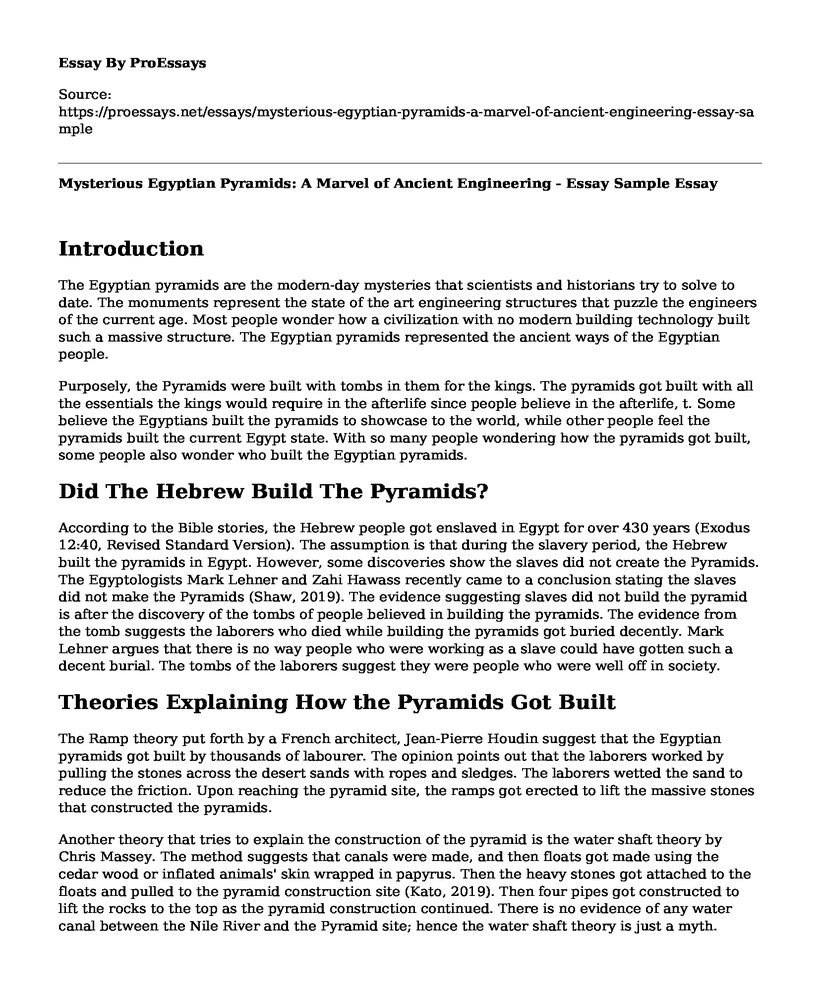Introduction
The Egyptian pyramids are the modern-day mysteries that scientists and historians try to solve to date. The monuments represent the state of the art engineering structures that puzzle the engineers of the current age. Most people wonder how a civilization with no modern building technology built such a massive structure. The Egyptian pyramids represented the ancient ways of the Egyptian people.
Purposely, the Pyramids were built with tombs in them for the kings. The pyramids got built with all the essentials the kings would require in the afterlife since people believe in the afterlife, t. Some believe the Egyptians built the pyramids to showcase to the world, while other people feel the pyramids built the current Egypt state. With so many people wondering how the pyramids got built, some people also wonder who built the Egyptian pyramids.
Did The Hebrew Build The Pyramids?
According to the Bible stories, the Hebrew people got enslaved in Egypt for over 430 years (Exodus 12:40, Revised Standard Version). The assumption is that during the slavery period, the Hebrew built the pyramids in Egypt. However, some discoveries show the slaves did not create the Pyramids. The Egyptologists Mark Lehner and Zahi Hawass recently came to a conclusion stating the slaves did not make the Pyramids (Shaw, 2019). The evidence suggesting slaves did not build the pyramid is after the discovery of the tombs of people believed in building the pyramids. The evidence from the tomb suggests the laborers who died while building the pyramids got buried decently. Mark Lehner argues that there is no way people who were working as a slave could have gotten such a decent burial. The tombs of the laborers suggest they were people who were well off in society.
Theories Explaining How the Pyramids Got Built
The Ramp theory put forth by a French architect, Jean-Pierre Houdin suggest that the Egyptian pyramids got built by thousands of labourer. The opinion points out that the laborers worked by pulling the stones across the desert sands with ropes and sledges. The laborers wetted the sand to reduce the friction. Upon reaching the pyramid site, the ramps got erected to lift the massive stones that constructed the pyramids.
Another theory that tries to explain the construction of the pyramid is the water shaft theory by Chris Massey. The method suggests that canals were made, and then floats got made using the cedar wood or inflated animals' skin wrapped in papyrus. Then the heavy stones got attached to the floats and pulled to the pyramid construction site (Kato, 2019). Then four pipes got constructed to lift the rocks to the top as the pyramid construction continued. There is no evidence of any water canal between the Nile River and the Pyramid site; hence the water shaft theory is just a myth.
The Ramp Theory
The ramp theory of pyramid construction holds some truth and gets believed to be the correct theory to date. The drawing ancient drawings show hundreds of laborers pulling the sled with giant statues on them. Evidence of the ramps found in the pyramid suggests that the ramp theory holds some truth in it. Computer scientists developed programs that tested the ramp theory blueprints and discovered it measures up mathematically.
Conclusion
The pyramids got built by thousands of Egyptians from low-income families who volunteered to work as laborers. Typically, the pyramids of Egypt got constructed for religious purposes. The tombs got built to support the afterlife of the ancient kings with all the items they needed. The pyramid construction remains a mystery because no one understands how ancient people with no civilization and technology built such massive structures. Engineers get puzzled about how the ancient community managed to construct such an arrangement with 2.3 million stones - each weighing roughly 1.5 tones. Another mystery of the pyramid is that it almost points to the precise true north.
References
Kato, A. (2019). How They Moved and Lifted Heavy Stones to Build the Great Pyramid. Archaeological Discovery, 8(1), 47-62. DOI: 10.4236/ad.2020.81003
Shaw, J. (2019). Who Built the Pyramids? Harvard Magazine. Retrieved from https://harvardmagazine.com/2003/07/who-built-the-pyramids-html
Cite this page
Mysterious Egyptian Pyramids: A Marvel of Ancient Engineering - Essay Sample. (2023, May 25). Retrieved from https://proessays.net/essays/mysterious-egyptian-pyramids-a-marvel-of-ancient-engineering-essay-sample
If you are the original author of this essay and no longer wish to have it published on the ProEssays website, please click below to request its removal:
- Afro-Futurism Creative Writing
- Theme and Symbols Combine With Stories: Paper Example
- Fictional Representations of Crime in TV Programs and Movies Paper Example
- George Braque and Raffaello Sanzio Comparative Essay Example
- Essay on Chungking Express: Wong Kar-Wai's Two-Part Tale of Love and Midnight Snacks
- Modern Heroes: Integrity, Honor, and Martial Arts - Essay Sample
- Essay Example on Frida Kahlo's 1932 Self Portrait: Symbolism of Mexico & US Industrialization







